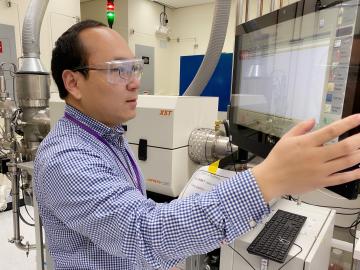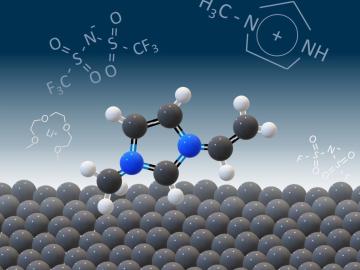
Filter News
Area of Research
- (-) Advanced Manufacturing (4)
- (-) Materials (78)
- (-) Nuclear Science and Technology (7)
- Biology and Environment (40)
- Computational Biology (1)
- Computer Science (2)
- Electricity and Smart Grid (1)
- Energy Science (79)
- Fusion and Fission (10)
- Isotope Development and Production (1)
- Isotopes (24)
- Materials Characterization (1)
- Materials for Computing (11)
- Materials Under Extremes (1)
- National Security (20)
- Neutron Science (27)
- Quantum information Science (1)
- Supercomputing (70)
News Type
News Topics
- (-) Artificial Intelligence (9)
- (-) Clean Water (2)
- (-) Grid (4)
- (-) Isotopes (13)
- (-) Materials Science (54)
- (-) Quantum Computing (2)
- (-) Space Exploration (4)
- 3-D Printing/Advanced Manufacturing (28)
- Advanced Reactors (7)
- Big Data (2)
- Bioenergy (11)
- Biology (4)
- Biomedical (5)
- Buildings (3)
- Chemical Sciences (27)
- Composites (5)
- Computer Science (18)
- Coronavirus (4)
- Critical Materials (8)
- Cybersecurity (4)
- Energy Storage (25)
- Environment (13)
- Exascale Computing (2)
- Frontier (2)
- Fusion (11)
- High-Performance Computing (3)
- ITER (1)
- Machine Learning (5)
- Materials (59)
- Mathematics (1)
- Microscopy (18)
- Molten Salt (3)
- Nanotechnology (29)
- National Security (3)
- Neutron Science (31)
- Nuclear Energy (31)
- Partnerships (11)
- Physics (26)
- Polymers (10)
- Quantum Science (10)
- Security (2)
- Summit (2)
- Transportation (8)
Media Contacts

The combination of bioenergy with carbon capture and storage could cost-effectively sequester hundreds of millions of metric tons per year of carbon dioxide in the United States, making it a competitive solution for carbon management, according to a new analysis by ORNL scientists.

About 60 years ago, scientists discovered that a certain rare earth metal-hydrogen mixture, yttrium, could be the ideal moderator to go inside small, gas-cooled nuclear reactors.

Radioactive isotopes power some of NASA’s best-known spacecraft. But predicting how radiation emitted from these isotopes might affect nearby materials is tricky

A team led by Oak Ridge National Laboratory developed a novel, integrated approach to track energy-transporting ions within an ultra-thin material, which could unlock its energy storage potential leading toward faster charging, longer-lasting devices.

Oak Ridge National Laboratory researchers have developed artificial intelligence software for powder bed 3D printers that assesses the quality of parts in real time, without the need for expensive characterization equipment.

Real-time measurements captured by researchers at ORNL provide missing insight into chemical separations to recover cobalt, a critical raw material used to make batteries and magnets for modern technologies.

Scientists seeking ways to improve a battery’s ability to hold a charge longer, using advanced materials that are safe, stable and efficient, have determined that the materials themselves are only part of the solution.

After its long journey to Mars beginning this summer, NASA’s Perseverance rover will be powered across the planet’s surface in part by plutonium produced at the Department of Energy’s Oak Ridge National Laboratory.

From materials science and earth system modeling to quantum information science and cybersecurity, experts in many fields run simulations and conduct experiments to collect the abundance of data necessary for scientific progress.

Five researchers at the Department of Energy’s Oak Ridge National Laboratory have been named ORNL Corporate Fellows in recognition of significant career accomplishments and continued leadership in their scientific fields.


